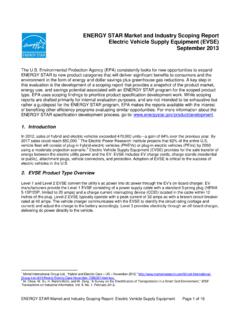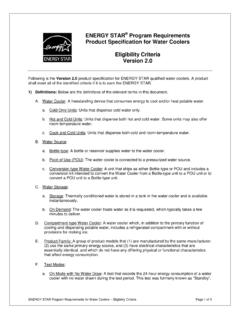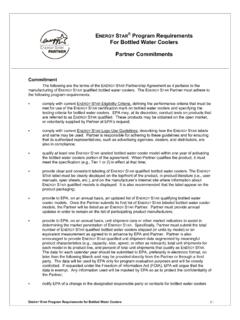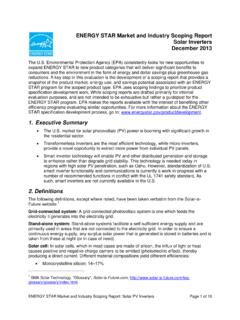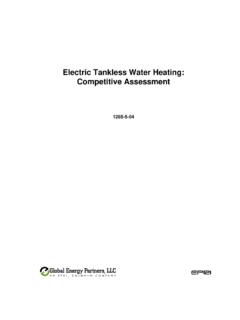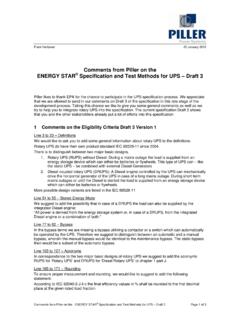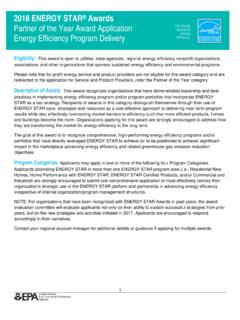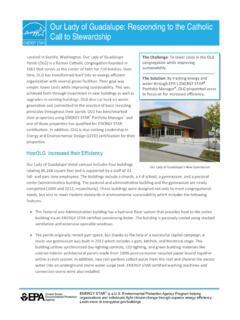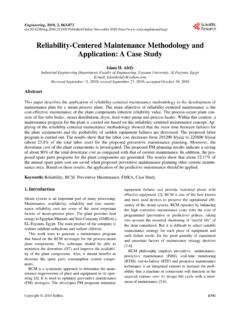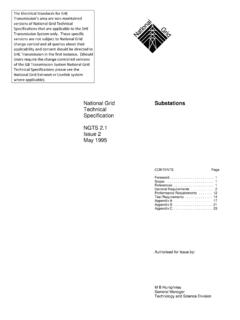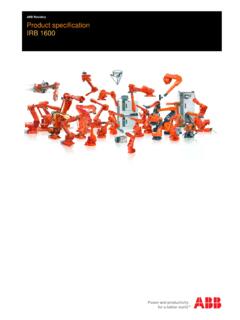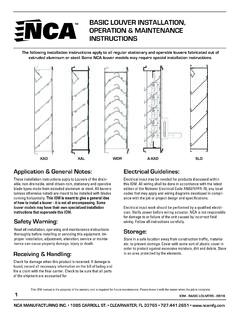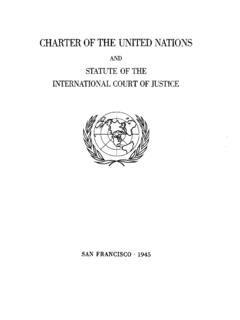Transcription of Operation and Maintenance Service Contracts
1 O&M Best Practices SeriesGuidelines for ObtainingBest-Practice Contractsfor Commercial BuildingsOperation andMaintenanceServiceContractsPrepared with funding from the EPAD ecember 1997 PECIA cknowledgementsSpecial thanks to the following people for their ongoingcontributions and careful review of the document:Byron Courts, Director of Engineering Services, andDave Rabon, Chief Engineer, Melvin MarkPete Degan, Director of Customer Marketing, Landis/StaefaDavid Fanning, HVAC Coordinator, EXPRESSBil Pletz, Facility Manager, IntelMike Sanislow, Service Channel Development Leader,Honeywell Home and BuildingKarl Stum, Director of Technical Services, PECITom Walton, President, United Service AllianceFor additional copies of this guidebook, contact:Portland Energy Conservation Inc. (PECI)921 SW Washington, Suite 312 Portland, OR 97205 Phone : of ContentsOperation and Maintenance Service 1 SURVEY AND DEFINITIONSWhat Is Operation and Maintenance ?
2 3 What Are the Various Types of Service Contracts ? ..3 Who Are the Providers? ..6 OBTAINING A BEST-PRACTICE O&M Service CONTRACTD eveloping Objectives ..9 Measurable Objectives ..10 Screening the Contractors ..10 Obtaining Bids and Selecting a Contractor ..12 WHAT TO INCLUDE IN A BEST-PRACTICE Service CONTRACTD ocumenting, Tracking, and Reporting Requirements ..14 The Facility O&M Service Plan ..15 Adding the O to an O&M Service Contract ..16 Calibration Requirements ..17 Certifications and Safety Requirements ..18 Contract Cancellation, Protocols, and General Considerations ..18 WHAT SHOULD A BEST-PRACTICE Service CONTRACT COST? ..21 TIPS FOR MANAGING AND OVERSEEING A BEST-PRACTICE Service CONTRACT ..221. Communication ..222. Documentation and Review ..223. Spot Checks ..22 Appendix AAN 8-STEP ACTION PLAN FOR OBTAINING A BEST-PRACTICE Service CONTRACT ..A-1 Appendix B: Sample Forms, Plans, and agreementsCONTRACTOR SCREENING FORM.
3 B-2 ITEMIZED LIST OF CHARGES ..B-5 Service PLAN FOR A CENTRIFUGAL CHILLER ..B-6 CONTRACTOR S HAZARDOUS MATERIALS/REFRIGERANT POLICY AGREEMENT ..B-12 Appendix CLIST OF ACRONYMS ..C-1 BIBLIOGRAPHY ..C-21 OVERVIEW AND GUIDELINESI ntroductionFrequently, building owners and managers outsource most if not all ofthe Operation and Maintenance (O&M) services for their building sys-tems. Even large national companies and institutions with in-house O&Mstaffs often use outside Service contractors to supplement their factors contribute to increasing business opportunities for O&Mservice providers in retail and office buildings. These include: Growing interest in indoor air quality (IAQ) issues Americans with Disabilities Act Phaseout of CFC refrigerants Building owners and managers desire to reduce operating costsand assure reliability Building owners and managers desire to be environmentallyresponsibleThe research required to design and obtain a good O&M Service contract isoften too confusing and time-consuming for the typical owner or managerto pursue.
4 The purpose of this document is to provide clear information onservice contract options and trends to commercial and retail building own-ers, facility managers, property managers, and chief building research and development of this document was conducted by Port-land Energy Conservation Inc. (PECI) and funded by the Atmospheric Pol-lution Prevention Division of the Environmental Protection Agency(EPA) in cooperation with the Department of Energy (DOE). This docu-ment does not attempt to specify the exact legal language to use in aservice contract; rather, it is a set of general guidelines. The main objectiveis to identify: What owners need to know to obtain a good Service contract Ways to evaluate Service providers Major Service needsOperation and MaintenanceService ContractsAn overview of current trends and options, withguidelines for obtaining and managing the bestcontract for your buildingApproximately 40% of allnonresidential buildingscontract Maintenance Service forheating, ventilating, and airconditioning (HVAC) third-party providers becomemore sophisticated in sellingservices, building owners andmanagers need to become betterinformed CONTRACTS2 What the contract should include Ways to ensure that the contracted services are correctly performedThis paper focuses on Service Contracts for heating, ventilating, and airconditioning systems and equipment.
5 The discussion is limited to contractsoffered by firms whose Service personnel work off site (as opposed tofirms providing Maintenance management services with key technical staffon site).3 OVERVIEW AND GUIDELINESS urvey and DefinitionsWhat Is Operation and Maintenance ?Building O&M is the ongoing process of sustaining the performance ofbuilding systems according to design intent, the owner s or occupants chang-ing needs, and optimum efficiency levels. The O&M process helps sustaina building s overall profitability by addressing tenant comfort, equipmentreliability, and efficient Operation , in the context of O&M, refers to activities such as sched-uling equipment and optimizing energy and comfort-control strategies sothat equipment operates only to the degree needed to fulfill its intendedfunction. Maintenance activities involve physically inspecting and caringfor equipment. These O&M tasks, when performed systematically, increasereliability, reduce equipment degradation, and sustain energy Are the Various Types of Service Contracts ?
6 In the Maintenance Service industry, there is no standard or set of defini-tions for the various kinds of Service Contracts . Each mechanical or mainte- nance Service contractor puts together a unique package of Contracts . Thepackage often consists of three or four types of Contracts , each presentinga different level of this document, four fundamental types of contract are defined: full-coverage, full-labor, preventive - Maintenance , and inspection newer concept of an end-use or end-results contract is also brieflydiscussed. The names used are based on industry literature and discussionswith professionals in the field. There can be many variations within a con-tract type, depending on owner needs and contractor willingness to modifyor customize Service of the contract types discussed below can encompass either the entiremechanical system or just one piece of major equipment such as a , owners may have more than one type of contract in place at anygiven Service ContractA full-coverage Service contract provides 100% coverage of labor, parts,and materials as well as emergency Service .
7 Owners may purchase this typeof contract for all of their building equipment or for only the most criticalequipment, depending on their needs. This type of contract should alwaysinclude comprehensive preventive Maintenance for the covered equipmentand it is not already included in the contract, for an additional fee the ownercan purchase repair and replacement coverage (sometimes called a break-down insurance policy) for the covered equipment. This makes the con-In the absence of asufficiently large and welltrained in-house O&M staff, Service Contracts may be the onlymeans of maintaining abuilding s mechanical systems inan organized, ongoing CONTRACTS4tractor completely responsible for the equipment. When repair and replace-ment coverage is part of the agreement, it is to the contractor s advantageto perform rigorous preventive Maintenance on schedule, since they mustreplace the equipment if it fails Contracts are usually the most comprehensive and the mostexpensive type of agreement in the short term.
8 In the long term, however,such a contract may prove to be the most cost-effective, depending on theowner s overall O&M objectives. Major advantages of full-coverage con-tracts are ease of budgeting and the fact that most if not all of the risk iscarried by the contractor. However, if the contractor is not reputable orunderestimates the requirements of the equipment to be insured, they maydo only enough preventive Maintenance to keep the equipment barelyrunning until the end of the contract period. Also, if a company underbidsthe work in order to win the contract, they may attempt to break the con-tract early if they foresee a high probability of one or more catastrophicfailures occurring before the end of the Service ContractA full-labor Service contract covers 100% of the labor to repair, replace, andmaintain most mechanical equipment. The owner is required to purchaseall equipment and parts.
9 Although preventive Maintenance and operationmay be part of the agreement, actual installation of major plant equipmentsuch as a centrifugal chillers, boilers, and large air compressors is typicallyexcluded from the contract. Risk and warranty issues usually preclude any-one but the manufacturer installing these types of equipment. Methods ofdealing with emergency calls may also vary. The cost of emergency callsmay be factored into the original contract, or the contractor may agree torespond to an emergency within a set number of hours with the ownerpaying for the emergency labor as a separate item. Some preventive main-tenance services are often included in the agreement along with minormaterials such as belts, grease, and is the second most expensive contract regarding short-term impact onthe Maintenance budget. This type of contract is usually advantageous onlyfor owners of very large buildings or multiple properties who can buy inbulk and therefore obtain equipment, parts, and materials at reduced owners of small to medium-size buildings, cost control and budgetingbecomes more complicated with this type of contract, in which labor is theonly constant.
10 Because they are responsible only for providing labor, thecontractor s risk is less with this type of contract than with a Service ContractThe preventive - Maintenance (PM) contract is generally purchased for afixed fee and includes a number of scheduled and rigorous activities suchas changing belts and filters, cleaning indoor and outdoor coils, lubricatingmotors and bearings, cleaning and maintaining cooling towers, testing con-trol functions and calibration, and painting for corrosion control. Generally5 OVERVIEW AND GUIDELINESthe contractor provides the materials as part of the contract. This type con-tract is popular with owners and is widely sold. The contract may or maynot include arrangements regarding repairs or emergency main advantage of this type of contract is that it is initially less expen-sive than either the full- Service or full-labor contract and provides the ownerwith an agreement that focuses on quality preventive Maintenance .
